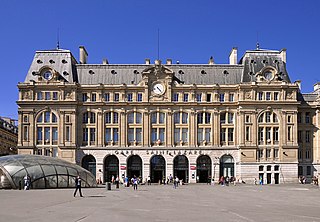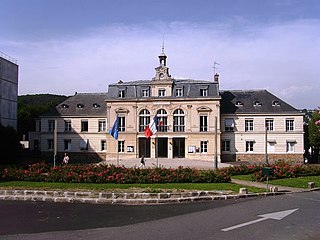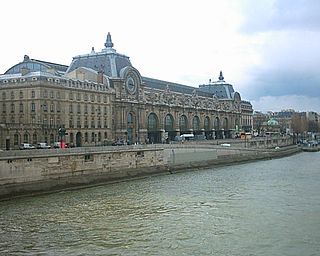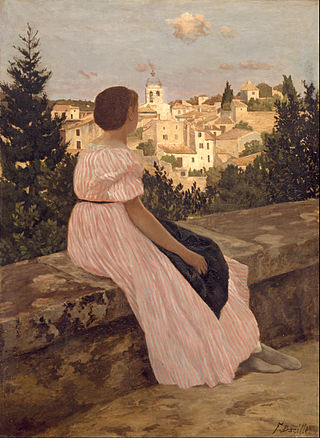
The Musée d'Orsay is a museum in Paris, France, on the Left Bank of the Seine. It is housed in the former Gare d'Orsay, a Beaux-Arts railway station built between 1898 and 1900. The museum holds mainly French art dating from 1848 to 1914, including paintings, sculptures, furniture, and photography. It houses the largest collection of Impressionist and post-Impressionist masterpieces in the world, by painters including Berthe Morisot, Claude Monet, Édouard Manet, Degas, Renoir, Cézanne, Seurat, Sisley, Gauguin, and van Gogh. Many of these works were held at the Galerie nationale du Jeu de Paume prior to the museum's opening in 1986. It is one of the largest art museums in Europe.

The Ligne de Sceaux was a railway line in France running from Paris, which initially linked the Place Denfert-Rochereau (then called the Place d'Enfer, in Paris, to the town of Sceaux.

The Gare de Lyon, officially Paris Gare de Lyon, is one of the seven large mainline railway stations in Paris, France. It handles about 148.1 million passengers annually according to the estimates of the SNCF in 2018, with SNCF railways and the RER D accounting for around 110 million and the RER A accounting for 38 million, making it the second-busiest station of France after the Gare du Nord and one of the busiest in Europe.

Gare d'Austerlitz, officially Paris Austerlitz, is one of the seven large Paris railway terminal stations. The station is located on the left bank of the Seine in the southeastern part of the city, in the 13th arrondissement. It is the start of the Paris–Bordeaux railway; the line to Toulouse is connected to this line. In 1997, the Ministry of Culture designated the Gare d'Austerlitz a historical monument; it became the fifth large railway station in Paris to receive such a label, as currently only Montparnasse has not been attributed it.

The Gare Saint-Lazare, officially Paris Saint Lazare, is one of the seven large mainline railway station terminals in Paris, France. It was the first train station built in Paris, opening in 1837. It mostly serves train services to western suburbs, as well as intercity services toward Normandy using the Paris–Le Havre railway. Saint-Lazare is the third busiest station in France, after the Gare du Nord and Gare de Lyon. It handles 290,000 passengers each day. The current station building opened in 1889 and was designed by architect Juste Lisch; the maître d'œuvre was Eugène Flachat.

The Gare d'Orsay is a former Paris railway station and hotel, built in 1900 to designs by Victor Laloux, Lucien Magne and Émile Bénard; it served as a terminus for the Chemin de Fer de Paris à Orléans. It was the first electrified urban terminal station in the world, opened 28 May 1900, in time for the 1900 Exposition Universelle.

Orsay is a commune in the Essonne department in Île-de-France in northern France. It is located in the southwestern suburbs of Paris, France, 20.7 km (12.9 mi) from the centre of Paris.

Musée d'Orsay is a station in line C of the Paris Region's Réseau Express Régional (RER) rapid transit system, named after the Musée d'Orsay, housed in the former Gare d'Orsay. It is in the 7th arrondissement of Paris, on the Quai Anatole-France. It was one of several stations attacked during the 1995 Paris Métro and RER bombings.

RER B is one of the five lines in the Réseau Express Régional, a hybrid commuter rail and rapid transit system serving Paris, France and its Île-de-France suburbs. The 80-kilometre (50 mi) RER B line crosses the region from north to south, with all trains serving a group of stations in central Paris, before branching out towards the ends of the line.

RER D is one of the five lines in the Réseau Express Régional, a hybrid commuter rail and rapid transit system serving Paris and its suburbs. The 190-kilometre (120 mi) line crosses the region from north to south, with all trains serving a group of stations in central Paris, before branching out towards the ends of the line.

Le Guichet station is one of the two RER stations of Orsay, near Paris, in France. It is also the name of a district of this town.
Musée d'Orsay is an art museum in Paris.

The Gare des Brotteaux is an old railway station located in the Brotteaux quarter, in the 6th arrondissement of Lyon.

The SNCF BB 1280 class were a class of 600 V DC 4 axle Bo′Bo′ electric locomotives, formerly Compagnie du chemin de fer de Paris à Orléans machines, initially built for an underground section of line connecting the Gare d'Austerlitz to the Quai d'Orsay in inner Paris. The locomotives were converted for 1500 V DC use in the 1930s, and renumbered PO E.281 to E.293. They were absorbed by the SNCF, and operated as shunters until the late 1960s.

Paris-Saclay University is a combined technological research institute and public research university in Orsay, France. Paris-Saclay was established in 2019 after the merger of four technical grandes écoles, as well as several technological institutes, engineering schools, and research facilities; giving it fifteen constituent colleges with over 48,000 students combined.

The Luxembourg Station in Brussels is a 1903 painting by Henri Ottmann. It's displayed at the Musée d'Orsay in Paris.

The théâtre d'Orsay was a theater located on the rive gauche of the Seine, in the 7th arrondissement of Paris

The Pink Dress is an oil-on-canvas painting by Frédéric Bazille, produced in 1864 when he was aged 23. The work is now in the Musée d'Orsay, in Paris.

Estelle de Barescut was a French painter and lithographer. She exhibited her lithographs at the Salon de Paris in 1834 and 1835, and her paintings from 1842 to 1851.


















